|
|
|
|||
|
|
||||
|
|
||||
| Smoke Trails | ||||
|
|
HOME | SITE MAP | FORUM | CONTACT |
|
||
|
ABOUT | MOTORS | MODELS | ARCHIVE | HISTORY | STORE | FAQ | LINKS
|
|
|
|
|
|
||||||||||||||||||||||||||||||||||||||||||||||||||||||||||||||||||||||||||||||||||||||||||||||||||||||||||||||||||||||||||||||||||||||||
|
Smoke Trails 8
(January 2007)
by Roger Simmonds Reprinted from SAM 35 Speaks, January 2007 Flights of Fancy The Internet has made the sharing of data, that is, plans and articles, as MPEGs, JPEGs, PDFs and the like, easy. But staring at the computer screen is curiously unsatisfying, and it is always rewarding to print electronic files – especially plans – and admire them as real objects. So it is with electronic colleagues: whilst it is good to correspond with like-minded folk over the aether, it is better to interact in actual, not virtual, reality. I had had a great time with Ben Nead, the Owner/Manager of Jetex.org, at the Solent Sky FROG/Jetex Meeting in 2005, so it was with great anticipation that I flew to Auckland to spend a few days with John Miller Crawford, our website Developer/Editor at the Jetex.org Production Studios. After some years of corresponding with John, I felt I knew him, but I didn’t know what to expect of this southern outpost of the Jetex.org Empire. I did have fantasies, though. I have a mind, you see, that is, for better or worse, and at least in part, informed by the humorous stories that appeared in copies of Aeromodeller and Model Aircraft in the fifties. These nicely ironic tales, reminiscent of Jerome K Jerome’s whimsies, helped me to put my own failures as a boy to build anything quite properly, or get anything to fly more than 20 seconds, in perspective. One particularly encouraging story (‘Beginner’s Luck’) is about a chap who finds several wrecked model aircraft, including the smoking remains of a jet, on his back lawn. Gathering these up, and becoming somewhat entangled in the rubber in the process, he calls on his new next-door neighbour. A gaunt, wild-eyed fellow greets him. He turns out to be an enthusiastic, if inept, aeromodeller, who is at first disappointed that the F.D.2 didn’t get further than next-door’s garden. Characteristically, though, he is not downcast for long. “Perhaps it went up a long way”, he muses. Spotting a potential recruit, he throws the wreckage onto an already large pile of similar wrecks in the hall and takes the narrator on a tour of the house, which proves to be singularly bereft of the usual home comforts. There is modelling paraphernalia everywhere: books, plans, building boards, drawing boards, models small and large (I believe one wall had been knocked down), and large stocks of modelling materials in every bedroom. Even the bath is full of soaking wood, the washbasin with microfilm. Somewhat bemused, the narrator is taken upstairs – more models under construction, more tools. Then he notices two chairs and an open tin of sardines with a spoon in a corner. “What’s that?” he asks. The modeller pauses his evangelistic monologue, trying to remember, “Oh”, he says at last, “that’s where we live!” The story continues with our hero, fired with enthusiasm, visiting the local modelling shop – and buying a marquettry kit by mistake! Nevertheless, after much trauma, he succeeds in getting this to fly, (albeit sideways) powered by a precursor of Tan II – his Aunty’s knicker elastic. It is, as I said, an encouraging story. I could identify with the protagonists and the scenarios, and, whilst my mother’s house didn’t resemble the modeller’s, my bedroom certainly could. I also had aunties like that. |
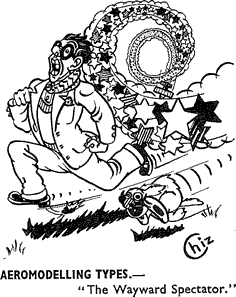  Jetex fliers, clearly, from the oral wick igniters and coils of wick issuing from the field box
- Aeromodeller, Dec. 1952 (upper) and May 1952
|
||||||||||||||||||||||||||||||||||||||||||||||||||||||||||||||||||||||||||||||||||||||||||||||||||||||||||||||||||||||||||||||||||||||||
|
So my expectations of John’s domestic arrangements were fanciful, to say the least. Would chez JMC be given over entirely to the demands of Jetex.org? Would there be uniformed guards? Would the receptionist allow me past the double doors and into the hallowed portals with only my passport and a somewhat grimy copy of SAM 35 Speaks as proof of who I am? It was, of course, not like that at all, and after John had shown me around his delightful book-lined abode, I hesitantly asked, “But where is Jetex.org?” Bluebeard-like, John opened another door. This led to a small study. He pointed to a small computer humming away happily to itself on the floor, “That’s it”, he said. “No separate office complex with fax machines, secretaries manning the call centre, and aged librarians attending to the miles of archives?” I asked, somewhat plaintively. “No”, said John. Well, I had a splendid time: we test flew John’s authentically-powered Panther (right), and I was able to peruse the archives John had garnered from all over the world. There were some items new to me: for example last month’s Telasco Cougar, Peter Chinn’s Jetex chapter in his All about Model Aircraft& (1958), and, most, gratifyingly, an article by Peter Cock, ‘Space ship Development’, that was published in Model Maker, April 1955. Before discussing this, does anyone else remember the light-hearted articles in the model magazines of the Fifties with affection? Does anyone remember who the authors were or kept any of them? (The stories, not the authors). Today’s magazines seem curiously humourless – perhaps because model flying has become big business – and I for one miss the light touch. It would be a pity if some of the better flights of fancy were lost forever. Is there a place for them in SAM 35 Speaks, or do we need a Society for the Preservation and Restoration of Ancient Tales? Tell me what you think. Peter Cock’s Remarkable Rocket |
 The Smoke Trails Transcription Department of the Jetex.org Production Studios, in the author’s imaginings
- Milton Kent and Son
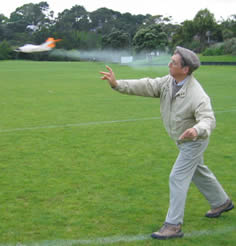 The author in Auckland, New Zealand, launching John Miller Crawford ’s “authentically-powered Panther”
- John Miller Crawford
|
||||||||||||||||||||||||||||||||||||||||||||||||||||||||||||||||||||||||||||||||||||||||||||||||||||||||||||||||||||||||||||||||||||||||
|
|
|
||||
|
As the editorial of the November 1945 Aeromodeller sternly reminded its readers, modification of fireworks was illegal. It was, however, widely practised (see John Park’s story last month). And hazardous (Rollie Lelliot once showed me his scars). But until the mid fifties, there were no legal (or less hazardous) options for the budding British rocketeer. Jetex rockets last featured in these columns in April 2004, where one of Peter Cock’s early attempts at ballistic flight, a 50B powered canard, was illustrated. A photo of its twin, also from Peter’s files, is shown on the right. Peter could remember little about these models, (this was, after all, fifty years ago), so I was delighted to find details of them and other progenitors of the ‘Dan Dare Space Ship’ in his 1955 Model Maker article. Peter, who is called a “Jetex design staff boffin”, begins his article, “The idea of a working model space ship must have entered the minds of many thousands of model builders […] Mr J N Mansour has for a considerable time nursed the idea of marketing a model space ship [Peter, perhaps diplomatically, does not mention the Zyra of 1950] […] Initial experiments were made with “stick” and “silhouette” type models, which were actually canard type aeroplanes distorted to look as much as possible like the popular conception of a space ship. The photograph shows a typical example. It is extremely light, approximately 10% of the motor and less than the thrust of the motor [20-25 grams or so]. It was trimmed to fly in a very steep climb with its longitudinal axis almost vertical and on completion of the motor run it would float down to earth in a gentle glide. Some very astounding performances were obtained, but it was found that any attempt to make them look like realistic space ships made them far too heavy and fragile; also they were very touchy indeed owing to the very high speed at which they flew under power.” Peter then describes experiments with pendulum controlled “nose elevators” to correct “any deviation from vertical flight in any direction”. These were not overly successful. At this stage, according to Peter, Mr Mansour expressed the opinion that there was insufficient power to give the initial acceleration, and he designed a combined launching ramp and catapult (below left) to “allow a model rocket with a 50B to fly straight up instead of wasting most of the motor run near the ground”. The first models tested could be “spectacular but erratic”, but it was found that a model powered by a 50B with an augmenter tube and weighing approximately 1½ oz would reach 100 feet on best attempts.
And thus the Wilmot Mansour Rocket Motor, the Jetex 50R (or 50HT in the US – below right) was born. It gave a thrust of 6 oz for 3 seconds, and allowed the design of more advanced models like the Tailored Space Ship (left). Reading between the lines of the article, Peter seems to have had more trouble with this one than Professor Peabody did with her originals, and it was not easy to develop into a reliable kit. In particular, the release mechanism gave lots of trouble and the parachute had to be folded very carefully indeed. Peter writes, “The first test flight was very spectacular indeed, the model passing almost out of sight […] three prototypes were eventually built and test flown repeatedly to make certain the design was as foolproof as possible. [italics mine]. Only one of the prototypes remains intact”. The curse of the Mekon, perhaps? Building and operating the model (and the somewhat lethal launch pad) was never easy, and neither Peter’s article nor any editorial comment in the Model Maker gave any indication of the sales of the 50R or popularity of the kit. For some reason the Eagle objected to the appropriation of their pilot of the future, and the ‘Dan Dare’ was quietly dropped from later adverts. When Sebel took over, the Space Ship was replaced by the less sophisticated Jetnik, which was launched by hand-held catapult and did away with the temperamental recovery mechanism. Understandable, but a pity all the same. Unbuilt examples of the Space Ship still turn up from time to time, at a price, of course. Fred Steer of ‘Potty Productions’ has one, and has plans to recreate them in plastic. Whether the complicated launch pad or the release mechanism could as easily be replicated is a moot point. These days, it is not necessary to power it with a Jetex 50R; I’m sure there is something in the Estes catalogue that might be suitable. |
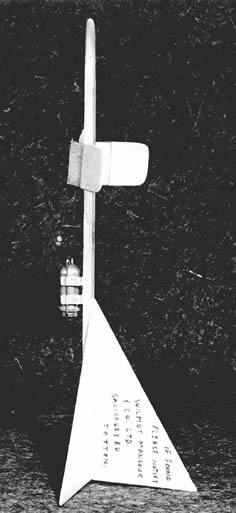 Peter Cock’s experimental canard for 50B; note WM’s address on the tail feathers
- Peter Cock
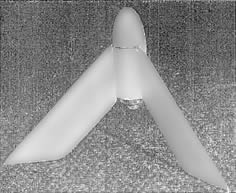 Peter Cock’s first simple pure rocket. It was designed for a ‘straight up straight down’ flight
- Model Maker, April 1955
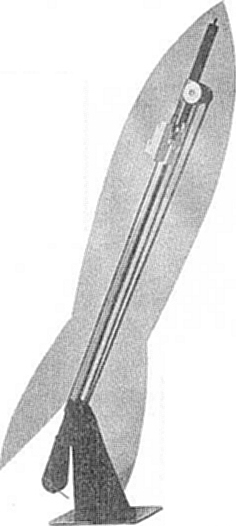 Joe Mansour’s bungee-powered catapult. According to Peter Cock, it could give models a ‘standing start’ of at least 12-15 feet. It looks a professional piece of apparatus; in contrast, the Dan Dare Launching ramp (left) was made of plywood and spring loaded
- Model Maker, April 1955
 An early US advertisement for the Jetex rocket motor
- Model Airplane News, Feb. 1963
|
||||
|
None of Peter’s canards were developed into kits. The later Sebel Viper missile for 50C (right) and the unpowered ‘Winged Missile’ show his influence, but by that time Peter had long left the company. However, Paul Del Gatto, that doyen of US Jetex modellers, published many ‘stick’ and ‘silhouette’ designs, (see the Jet(X) Files May 2004), and his X-15 for PAA-Loader was by all accounts a spectacular performer. He also designed ‘space ships’ for the 50HT, singly or in combination with other motors like the Scorpion. These two-stage rockets were even more complex than any of Peter’s creations, but I don’t think they had a launch catapult. His descriptions in his booklet, All About Jetex, published by Telasco in the US, unfortunately gives few details of these very ambitious designs. Jetex and Rapiers – the next Generation? |
 Sebel’s silhouette Viper missile for Jetex 50C
- Model Aircraft, Jan 1960
|
||||
|
As was discussed last month, some of the new batches of Rapiers have been unreliable (see right). John Park reflects the frustration of many us who have ended the year with models that have crashed, burned, or both. He writes: “Fifty years ago, Jetex motors were so safe, reliable and easy to operate that a child could do it unsupervised. In all my years of Jetex flying, I never burned a model or myself. I've been thinking very carefully about this, to make sure I'm not suffering from a bad case of ‘rose-tinted spectacles’, but Jetex really was that good in the early days – up to, say, 1956, before the change of ownership of the company and the ending of the connection with ICI. Surely, surely, it can't be beyond the wit of man to produce something of the same standard now?” I came to Jetex a little later than John. Like him, I was entirely unsupervised, but I could certainly have done with some help (I didn’t meet Rollie Lelliot until later in my modelling career). Things had, as John implies, changed, and ‘Jetex Jim’ could so easily have become ‘Jaundiced Jim’. The original 50 was splendidly engineered: the ribbed case and end cab were machined and the tension spring had an aluminium sleeve that made its action positive and resistant to twisting. The 50B needed more careful handling: the case and end cap were extruded, and leaks were common if the edge of the case was chipped (easily done) or the end cap distorted. The 50C was even more prone to ‘backfire’, not because of damage to the robust steel case, but because the nozzle was easily blocked – an implicit acknowledgement of this being the makeshift deflector. Also, it glowed, and the mounting clip screws could get so hot they could char the mounting block. I certainly did burn a couple of models, and myself – even now, I can remember the smell of granny’s ‘Wintergreen’ ointment mingled with Jetex fumes and singed flesh. Fortunately, I had more success with the 50R (used as a 50C). However, I take John’s final point: why (oh why) are there are no alternatives to Rapiers, and why (ditto) are we still using old Jetex motors and fuel? The short answer is that what we do is now very much a minority interest. No one is able to invest enough time, money, or expertise, to develop a cheap and consistent (read commercially viable) product. Dr Zigmund’s problems, whilst fuelling the ‘why oh why’ debate, actually exemplify the challenges facing any entrepreneur. The Jetex motor itself, despite some of the dreadful ‘ersatz’ examples seen over the years, is not the main problem. Examination of an original motor and access to a CNC lathe would (so I believe) enable the fabrication of a decent facsimile. In lieu of the now unacceptable asbestos, space age Nomex or Kapton washers could be used, and one would end up with a decent product at a price many people would be willing to pay. In contrast, examination of the pellets would not tell you very much, or facilitate their replication. I am not convinced that propellant chemistry (for our applications) has moved on in the last sixty years; so much pyrotechnical know-how and first-hand knowledge of pellet manufacture has been lost that to come up with a modern equivalent will now require extensive experimentation. It bears repeating how much expertise went into the original ICI ‘Power Cartridges’, and that a really clever chap like Bert Judge, with all the facilities of Sebel at his disposal, took a year to develop and refine a viable formulation for Sebel. More recently, Powermax, even with all their resources and commercial guile, never achieved a consistent product. Some correspondents have suggested that all the development of a new product requires is to “simply follow the patents, which are now all in the public domain”. But this is just not so; with regard to the fuel especially, patents cannot tell the whole story, and many variables in composition, grinding and pelleting will need to be redefined. In our interview with him in May 2006, Dr Alex Hutchison, author of the original ICI patents, gave some valuable insights into the subtleties of the ICI formulations: “I needed nitrophenols as catalysts. D.N.R., dinitro resorcinol, was the best I tested. I looked at nitro-compounds, nitrates that carry some oxygen, as you need oxygen to balance out your fuel and your oxidiser. If you get them ‘too balanced’, you get an explosive, so it was a nice balance. One thing that gave me great satisfaction was the small amount of asbestos [put in the original formulation] […] that was good thinking; I’m proud of that. These days you couldn’t put asbestos in formulations, but it’s absolutely vital, you’d cut your production of gas by 20% at least if you don’t have that tiny quantity of 0.5% asbestos. It forms a skeleton on which the catalytic reaction takes place; it’s a surface catalysis and if you don’t have a surface for this [the reaction gases] get blown out of the jet and you don’t get the full reaction taking place, only part. Kaolin or Nomex fibre might work, but you’d have to try it out in the lab. The gauze certainly wasn’t put in with any catalytic reaction in mind; it was really there to make sure the surface was lit evenly and you were burning across the full surface of the pellet.” |
 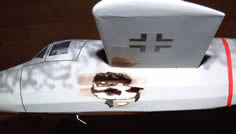 A failed Rapier L-2HP and the damage inflicted on Steve Bage’s Bachem Natter
- Steve Bage
|
||||
|
Now here is something of a paradox: we know rather a lot about the development of the Jetex propellants, thanks to first-hand sources like Bert Judge and Alex Hutchison, but to reproduce their work would be very challenging. Little is known about the development of Jetex motors; those involved have, it would appear, left no record, but to make replica motors is comparatively straightforward. To conclude: the difficulties of producing a commercial product should not be underestimated, and the resources required these days are probably beyond any amateur who hasn’t won the lottery. Am I being overly pessimistic, a Jetex Jeremiah? I hope so. Ben Nead is hoping to produce a proper ‘Millennium 50’ motor based on the 50B with a machined, not extruded, end cap of 321 alloy stainless steel (right) and is looking at a new propellant with electrical ignition. There are also rumours of approaches to Chinese and Indian manufacturers. I applaud these efforts, and I hope they bear fruit, but I’ll believe it when it happens! Ancient Novelties This splendid phrase comes from Pierre Claudy, who has provided more details of the Northrop F-89 Scorpion he made as a boy. The design, for Jetex 100, turns out to be by our old friend A Dautin. Pierre recalls, “I redrew the plan for two Jetex 50s, which was much more elegant than that for the Jetex 100, since it more faithfully reproduced the appearance of the plane. Both versions meet all the requirements to make excellent flying models. Unfortunately, I have no photographs.” Pierre’s version for twin Jetex 50 power is indeed more elegant (in fact très élégant), and could easily be adapted for two Rapier L-2s. |
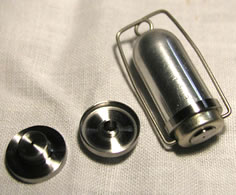 The ‘Millennium 50’ prototype: 50B case, but new end cap turned from 321 alloy stainless steel
- Ben Nead
|
||||
 The Cougar we discussed last month isn’t quite as unusual as I had thought. John Miller Crawford found this equally impressive Panther on the (new to me) Italian Flying Model Aircraft Magazines website. |
|
 A Dautin’s unique design of the F- 89 Scorpion for enclosed Jetex 100 (year and source unknown, can any reader help?), with version for two Jetex 50Bs and augmenter tubes by Pierre Claudy
- contributed by Pierre Claudy
|
|||
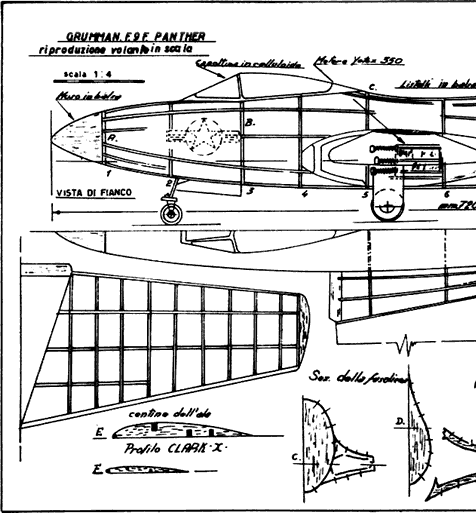 In contrast to the Dautin Scorpion, this complex Panther will need the ‘Bage touch’ to be a viable proposition; a nice design, however. Like the Telasco Cougar, it dates from 1958, and the mighty Jetex 350 is specified. I wonder if Paul Del Gatto knew of it? |
|
 Italian design of the Panther for enclosed Jetex 350. Interestingly, ‘Jetex’ is spelt, and probably pronounced, ‘Yetex’ in Italian. Not many people know that
- Fare No 25, 1958
|
|||
|
|
|||||
|
|
|
||||
|
|
|
|
|
|
|
|
Acknowledgements - Article: Roger Simmonds - Illustrations: Roger Simmonds, Steve Bage, Pierre Claudy, Peter Cock, John Miller Crawford, Grif Ingram, MAAC archives via Bill Henderson, Roger Winter |
|
|
|
|
ABOUT | MOTORS | MODELS | ARCHIVE | HISTORY | STORE | FAQ | LINKS |
|
|
Terms of Use
|
Queries? Corrections? Additions?
Please
contact us.
|
|